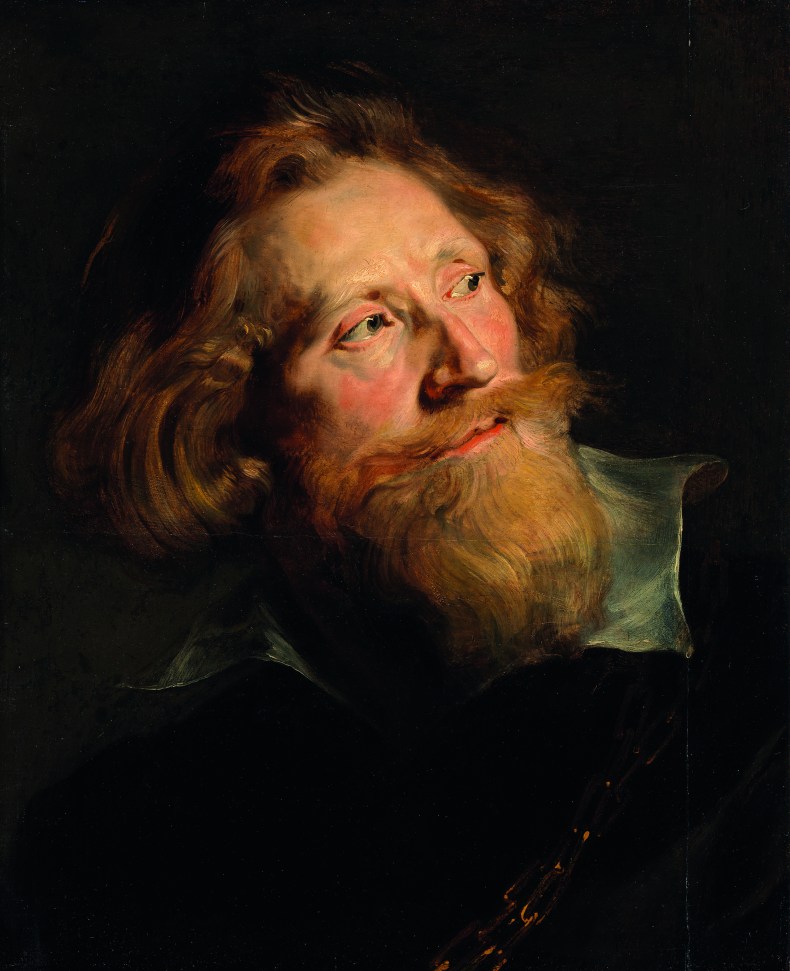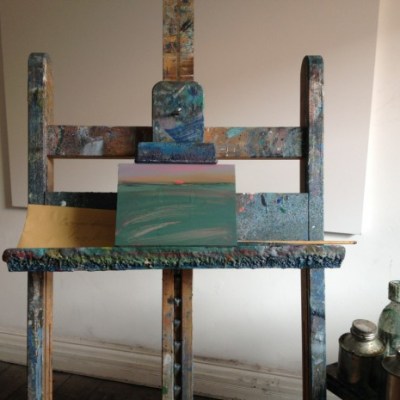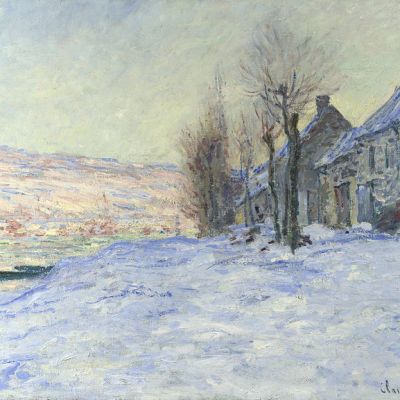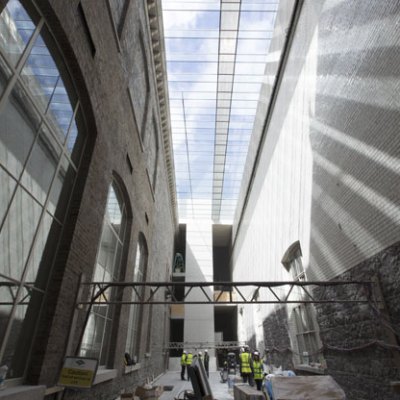When Sean Rainbird relinquished his position as director of Stuttgart’s Staatsgalerie in early 2012 to take up the equivalent position at the National Gallery of Ireland, the latter was in the middle of a major refurbishment and the work was expected to be finished by 2014 or at latest the start of the following year. It is, however, only later this month, five years into Rainbird’s tenure, that the NGI is finally reopening.
Much of the delay was owing to problems arising from the unplanned evolution of the National Gallery of Ireland, which the refurbishment has had to solve. The building, Rainbird observes, consists of ‘four different wings having four different narratives’. The original block, today known as the Dargan Wing, opened on a site overlooking Dublin’s Merrion Square in 1864. There had been moves for the establishment of such an institution for at least a century: in a 1767 essay, the Anglican clergyman Thomas Campbell expressed his regret that ‘we have no publick statues, no publick galleries of pictures, no academies for either painting or sculpture.’ Two decades later the 4th Duke of Rutland, the country’s Lord Lieutenant, conceived the notion of an Academy of Painting in Ireland incorporating a gallery for the display of Old Masters. Unfortunately, the duke died on a tour of the island and his scheme was laid aside. It was revived thanks to the railway magnate and philanthropist William Dargan who in 1853 underwrote the cost of a Great Exhibition in Dublin. Dargan insisted that a third of the space be devoted to art and, when the painting and sculpture hall became the event’s most popular attraction, the idea of a permanent gallery was reborn. Just over a decade later, the National Gallery of Ireland opened. Erected at a cost of almost £30,000, its exterior mirrored that of the Natural History Museum on the other side of an open space called Leinster Lawn. The collection was a modest affair; the sculpture hall contained plaster casts of Greek and Roman originals and a handful of original pieces. Of the 130 works on display in the picture gallery a few had been donated and 28 were loaned by the National Gallery in London. Sixty-five paintings had been bought, 39 of them as a group purchase in Rome, including works from the late Cardinal Joseph Fesch’s collection: these included many 17th-century baroque paintings, then out of fashion and so acquired for relatively low prices.
Frederick Hervey, bishop of Derry, with his granddaughter, by Hugh Douglas Hamilton (1798), being rehung at the National Gallery of Ireland

In the beginning the gallery had little work by Irish artists, since the focus of its first director George Mulvany was on acquiring Old Masters. His efforts were assisted from 1866 onwards by successive governments providing an annual purchase grant of £1,000, a figure that, other than being suspended for the duration of the First World War, remained unchanged until 1938. Among Mulvany’s best acquisitions were pictures by Zurbarán (bought for £5), Murillo, Rubens, and Giordano. Within a matter of years it became apparent more room was needed to accommodate the growing collection and a second block, the Milltown Wing, was completed in 1903.
In 1897, the Countess of Milltown had offered the entire contents of her late husband’s family house Russborough, County Wicklow. Together with an outstanding collection of furniture and silver, the gift included many paintings bought by the first and second earls during their respective Grand Tours: the inevitable portraits by Batoni as well as work by Panini, Carriera, Reynolds and, the great prize, a Holy Family by Poussin. Two more paintings by Poussin entered the collection following the death of the gallery’s fourth director, Sir Hugh Lane, who had also either donated or bequeathed work by El Greco, Chardin, Claude Lorrain, Titian, Sebastiano del Piombo, and many others.
The Holy Family, with Saints Anne, Elizabeth and John the Baptist (1649), Nicolas Poussin. National Gallery of Ireland

The collection of Irish work, neglected by Mulvany, also began to grow. This process was greatly aided by the publication in 1913 of a two-volume Dictionary of Irish Artists compiled by the gallery’s registrar Walter G. Strickland. As late as 1907 the Irish pictures were still hung in a section reserved for the British School and it was only after Ireland achieved independence in 1922 that more attention rightly started to be focused on this aspect of the national patrimony. At the end of that decade, the gallery’s seventh director, Thomas Bodkin, rehung the entire collection and took advantage of this opportunity to set aside a generous section of the building for Irish pictures (he also returned to London some works which had been on loan since the previous century). Today the Irish Rooms, with representative examples by 18th-century artists such as George Barret, Thomas Roberts, and Hugh Douglas Hamilton, to 20th-century masters like Jack B. Yeats, William Orpen), John Lavery, and Roderic O’Conor, are among the most frequented in the gallery. It has also received substantial legacies from the estates of Irish artists. In 1919, for example, the widow of Nathaniel Hone the Younger gave the gallery over 200 paintings and over 330 watercolours by her husband, and in 1996 Anne Yeats donated her uncle Jack B. Yeats’s archive, including more than 200 sketchbooks.
The Holy Well (1916), William Orpen. National Gallery of Ireland

A third expansion was proposed by the gallery’s Board of Governors in 1929. It finally began in 1964, was completed in 1968, and has come to be known as the Beit Wing after the donation almost 20 years later by Sir Alfred Beit and his wife Clementine. Their gift of 17 pictures includes work by Vermeer, Goya, Velázquez, Gainsborough, Steen, Ruisdael, Metsu, Murillo, Raeburn, and Hals. And then, at the start of the present century the Millennium Wing (designed by Benson & Forsyth) opened.
Much of the refurbishment budget of over €25 million has been spent on essential but largely invisible work. Rainbird, who sheds his unruffled manner to rhapsodise over the project’s technical details, points out that for the first time the gallery has an integrated system of lighting, heating, security and so forth. ‘It’s very much state of the art,’ he enthuses. ‘We’ve been able to specify really good technical equipment.’ For the past six years the team involved in the gallery’s renovation has been liaising with other institutions in Europe undergoing similar overhauls such as Stockholm’s National Museum and the Gemäldegalerie Alte Meister in Dresden. One of the most important, if least visible, elements in the renovation was relocating the energy centre. The entire Merrion Square forecourt was dug out to hold a new plant nine metres below ground, which meant that the Dargan and Milltown Wings immediately behind it needed to be underpinned. Indoors, most of the new technology has been concealed within existing spaces.
There is, however, enough discernible difference to satisfy anyone querying costs and time overruns. Since 2011 public access to the site has been through a self-effacing entrance in the Millennium Wing. Now the altogether grander doors on Merrion Square will once more be open, leading into a familiar but much-refreshed lobby. Structurally most of what lies beyond will be recognisable because, as Rainbird points out, ‘our choices were dictated by the fact that this was a conservation project.’ Nevertheless architectural practice Heneghan Peng, which worked with the Irish state’s Office of Public Works, has allowed itself a couple of discreet interventions. The first of these is a reinstatement: the opening of long-hidden windows along the ground-floor walls of both wings, thereby hugely increasing the flow of natural light into the rooms. The greatest novelty is the creation of a top-lit courtyard in what until now had been just a gap between the two oldest wings. But Rainbird has resisted the temptation of inserting a café or a gift shop in the space and insists that the courtyard will hold nothing more than some benches, allowing visitors a chance for reflection.
Head of a Bearded Man (1622–24), Peter Paul Rubens. National Gallery of Ireland

In recent years approximately five per cent of the national collection has been displayed in at most 13 and sometimes as few as five rooms. Thanks to the restitution of the older wings that proportion will now rise to 25 per cent. The amount might have been still greater but for the reopening of previously boarded-up windows. The opportunity effectively to start from scratch has also permitted the fresh designation of certain areas. At the back of the Dargan Wing a long gallery divided into a series of alcoves is being used to display work from the National Portrait Collection which, although initiated in 1875, has never found a comfortable resting place.
Rainbird seems determined to emphasise the positive aspects of what was in effect enforced stasis: ‘There was a huge level of activity. We didn’t just move all the pictures – we went through the entire inventory and checked everything here. And we carried out our first frame survey.’ With regard to exhibitions during the period, ‘We said, “Let’s do things” and encouraged curators to pick ideas out of their back pockets, show a bit of creativity and come up with shows that could take place using what was in the permanent collection and in a couple of rooms. Otherwise things would have become very stale.’ This rotation of work has been one of the factors ensuring that the gallery’s visitor numbers has held up over the past six years. The NGI remains Ireland’s most popular free attraction, with 718,000 visitors in 2015 (the last year for which figures are currently available).
There was some disquiet two years ago when a run of rooms usually devoted to well-known and loved pictures from the Irish collection were temporarily rearranged to accommodate an exhibition of work by Dublin-born Sean Scully. The NGI is predominantly a historical repository and it tends to acquire work that is at least half a century old. ‘The buffer of time as a prover of quality’ is how Rainbird summarises the museum’s policy. It is also important not to step on the toes of other establishments operating within the same field, in this instance the Irish Museum of Modern Art and Dublin City Gallery The Hugh Lane, both in the capital, and the Crawford Art Gallery in Cork. ‘We regularly talk to each other,’ says Rainbird, adding ‘there are these cordialities. You come to an understanding.’ The fact that the Hugh Lane has a permanent space dedicated to Sean Scully and that the Crawford also hosted an exhibition of the artist’s work in 2015 – helps to explain the unease over the NGI show. But, as Rainbird points out, ‘we made sure some of the Irish favourites were up in the final room of the Beit wing.’
A busy programme of exhibitions began in February with ‘Beyond Caravaggio’ (already seen last winter in London’s National Gallery). In the middle of this month, timed to coincide with the reopening of the NGI, ‘Vermeer and the Masters of Genre Painting’, organised in collaboration with the Musée du Louvre, Paris, and the National Gallery of Art, Washington, opens in Dublin for a three-month run. Rainbird says, ‘I don’t want to go for the quarter-of-a-million Monet shows […] We plan to build a programme around what we have in our own collection and what we can afford to bring in. We need to create a balance.’
With regard to the funding of exhibitions, the Irish state provides what Rainbird describes as ‘a modest amount’ towards the programme, adding that the sum is ‘far less even compared to what it was six or ten years ago’. When the Millennium Wing was built, a grant of €9.52 million was provided from the EU Regional Development Fund, private donors gave €6 million, the gallery drew on its own reserves to the tune of €4 million and the government of the time came up with €3.17 million.
Portrait of Doña Antonia Zarate (c. 1805), Francisco de Goya. National Gallery of Ireland

The NGI’s renovation programme was initiated when the country was in recession and the institution was required to come up with some 40 per cent of the €25 million-plus budget even though the building it occupies is the responsibility of the Office of Public Works. From 2010 until the present year the museum spent no money on acquisitions. During the economic crisis the gallery’s annual grant fell by over 40 per cent and there was an embargo on recruitment, despite the departure of a number of key curatorial figures. The situation is beginning to improve. In 2016 the government’s total allocation to the gallery was €7,636,000; this year it is €9,394,000. This is still at least 15 per cent less than what the state provided a decade ago.
One of the most significant sources of support has been from wealthy individuals donating work to one of Ireland’s designated cultural institutions, thus benefiting from an 80 per cent credit against their tax liabilities. Section 1003, as it is known, has served the NGI well although, Rainbird says, ‘in the downtimes it dried up completely’. Through the scheme the gallery has received pictures by Rubens and Teniers. However there is an annual cap of €6 million on the scheme, which must be shared between all the designated institutions.
Jacob Blessing the Sons of Joseph (c. 1620), Guercino. National Gallery of Ireland

But the gallery’s own acquisitions budget can now be used once more for the purpose intended. It includes two significant legacies: that of an earlier director, Sir Hugh Lane, who left the greater part of his estate to create a picture-buying fund for the gallery, and that of George Bernard Shaw who left one-third of his royalties to the institution, in memory of the happy times he had spent there during his childhood. Since the film of My Fair Lady, the musical version of his play Pygmalion, was released in 1964 the Shaw Fund has often amounted to a six-figure sum, but it runs out in 2020, 70 years after Shaw’s death. More recently, Sir Denis Mahon, who had already donated eight paintings – including Guercino’s Jacob Blessing the Sons of Joseph – some years before he died in 2011, left his entire library and his personal papers to the NGI. Nine hundred boxes duly arrived at the gallery, 500 of them filled with books. A four-year cataloguing programme is now underway. The gallery’s library currently occupies a portion of the basement adjacent to the 1960s Beit Wing, which has not been included in the recent restoration. Its overhaul, Rainbird explains, ‘will see the Beit Wing stripped to its basic structures, as it’s now at the end of its design life.’ It remains unclear whether the state is prepared to provide the necessary funds and until this is known work cannot begin.
It must be frustrating for Rainbird, but he retains his customary composure, as he does about having to re-apply for the job of NGI director. His contract came to an end last April, and the position was duly advertised. But Rainbird has not let this hold him up. ‘There’s plenty more work to be done […] I’d like to see how we work with the building – which I’ve never seen since being here.’ Finally the opportunity has arrived for him to act like the director of a national institution rather than supervisor of a building programme. ‘I haven’t had a shop window,’ Rainbird says. His moment has come: the ‘shop’ is about to open for business.
The National Gallery of Ireland, Dublin, reopens on 15 June.
From the June 2017 issue of Apollo. Subscribe here.


